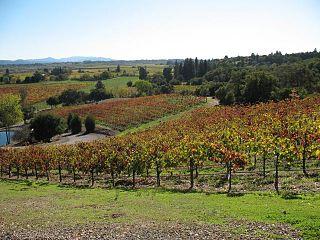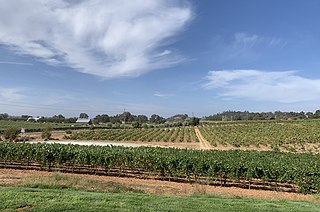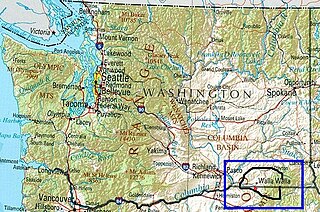
Arroyo Seco is an American Viticultural Area (AVA) in Monterey County, California, southeast of Monterey Bay. The appellation encompasses 18,240 acres (29 sq mi) in the valley adjacent to the Arroyo Seco Creek with approximately 8,500 acres (3,440 ha) of cultivation. The region's proximity to the Pacific Ocean produces the maritime climate, and is best suited for those cool climate grape varieties.

Willamette Valley is an American Viticultural Area (AVA) which lies in the Willamette Valley of Oregon. The AVA is the wine growing region which encompasses the drainage basin of the Willamette River. It stretches from the Columbia River in the north to just south of Eugene in the south, where the Willamette Valley ends; and from the Oregon Coast Range in the west to the Cascade Mountains in the east. At 5,360 square miles, it is the largest AVA in the state, and contains most of the state's wineries; approximately 908 as of 2021.

Columbia Valley is an American Viticultural Area (AVA) which lies within the Columbia River Plateau, through much of central and southern Washington state, with a section crossing the state boundary into northern Oregon south of the Columbia River. The viticultural area includes the drainage basin of the Columbia River and its tributaries through much of Washington. It was established by the Bureau of Alcohol, Tobacco and Firearms (ATF), Treasury on December 13, 1984 after evaluating the petition filed by Drs, Walter Clore and Wade Wolfe of Prosser, Washington on behalf of Washington’s oldest and largest winery, Chateau Ste. Michelle, and by William Blosser of the Sokol Blosser Winery, Dundee, Oregon. Allen Shoup, president of Chateau Ste. Michelle, understood the importance of obtaining appellation status to grow the reputation of the Northwest viticulture industry.

Santa Maria Valley is an American Viticultural Area (AVA) which straddles the boundary of Santa Barbara and San Luis Obispo counties in California's multi-county Central Coast AVA. It was established on August 5, 1981, by the Bureau of Alcohol, Tobacco, Firearms and Explosives (ATF) as California's second oldest AVA. A portion of the AVA crosses the Cuyama River into the southernmost corner of San Luis Obispo County. The east–west orientation of the 152.3 square miles with a wide, open valley and rolling hills means cool winds and fog flow in freely from the Pacific Ocean, settling most noticeably in lower-lying areas. The result is a mild Mediterranean climate that lengthens the growing season and contributes to the eventual sugar/acid balance in the grapes from Santa Maria Valley's 7,500 acres (3,000 ha) cultivated vineyards. On January 28, 2011, the AVA was granted an 29.4 square miles expansion to its southern boundary.

Temecula Valley is an American Viticultural Area (AVA) in the Temecula Valley, located in southwestern Riverside County, California against the eastern slopes of the Santa Ana Mountains. It was initially established by the Bureau of Alcohol, Tobacco and Firearms (ATF), Treasury as "Temecula" on October 23, 1984 based on submitted petitions from by the Rancho Califomia/Temecula Winegrowers Association and Callaway Vineyard and Winery, Temecula, California in 1982. It was renamed "Temecula Valley" by the Alcohol and Tobacco Tax and Trade Bureau (TTB) in 2004, approving the 2001 petition by Temecula Valley Winegrowers Association. The petition stated the name change would provide a more accurate description of the Temecula geography and greater clarity as to its location for wine consumers and the public. The petition did not request any change to the established AVA boundaries. This was the first American Viticultural Area to change its name after the initial approval. Temecula Valley encompasses 33,000 acres (52 sq mi) and 5,000 acres (8 sq mi) is located in a "protected" area referred to as the Citrus/Vineyard Zone. This area is generally located in and around the Rancho California Road area with Riverside County. County guidelines strictly enforce the number of acres needed to build a winery, lodging and other limited housing and commercial ventures.
Monticello is an American Viticultural Area (AVA) located in the central Piedmont region of the Commonwealth of Virginia. It was established by the Bureau of Alcohol, Tobacco and Firearms (ATF) on February 22, 1984 after six wine grape growers in the Charlottesville area petitioned the ATF to designate a viticultural area to be known as “Monticello.” The name "Monticello" is known nationally and locally as the historic home of Thomas Jefferson, located near the center of the area. Monticello AVA includes most of Albemarle, Fluvanna, Greene, Orange, and Nelson counties. The area is nestled along the eastern slopes of the Blue Ridge Mountains and encompasses the small ridge known as the Southwest Mountains. There are approximately 30 varieties of grapes grown in the Monticello AVA. However, the most notable grapes grown in the area include Cabernet Franc, Chardonnay and Viognier. The hardiness zone is 7a except in some higher vineyards which are 6b. In 2019, the Tax and Trade Bureau (TTB) granted a petition to expand the AVA by approximately 106,240 acres (166 sq mi) into Fluvanna County.

Central Coast is a vast American Viticultural Area (AVA) that spans along the Central California Pacific coastline from the San Francisco Bay Area south through Monterey, San Luis Obispo and Santa Barbara Counties. It was established on November 25, 1985 by the Bureau of Alcohol, Tobacco and Firearms (ATF), Treasury after reviewing the petition submitted by Taylor California Cellars, a winery in Gonzales, California, to establish the "Central Coast" viticultural area. The boundaries of the Central Coast, which have been expanded twice, includes portions of six counties where approximately 100,000 acres (40,469 ha) cultivated with Chardonnay being more than half of the varietal. Within the multi-county AVA are numerous established appellations that share the same maritime climate produced by the Pacific Ocean.

Sierra Foothills is a vast American Viticultural Area (AVA) encompassing the foothill "belt" of the Sierra Nevada in north-central California, United States. It was established on December 18, 1987 by the Bureau of Alcohol, Tobacco and Firearms (ATF), Treasury after evaluating the petition filed by the Sierra Foothills Winery Association of Somerset, California for the establishment of a "Sierra Foothills" viticultural area in portions of Yuba, Nevada, Placer, El Dorado, Amador, Calaveras, Tuolumne and Mariposa Counties. Wine grapes were introduced to the area in the nineteenth century during the California Gold Rush. Over 280 vineyards/wineries are located within its boundaries.

The North Coast AVA is an American Viticultural Area in the state of California that encompasses grape-growing regions in six counties located north of San Francisco: Lake, Marin, Mendocino, Napa, Sonoma, and Solano. This large appellation covers over 3,000,000 acres (5,000 sq mi) and includes a number of smaller sub-appellations that all share the common ecology trait of weather affected by the fog and breezes off the Pacific Ocean.

California Shenandoah Valley is an American Viticultural Area (AVA) located within portions of Amador County and El Dorado County, California. The area was established on January 27, 1983 by the Bureau of Alcohol, Tobacco, Firearms and Explosives (ATF), Treasury after approving the petition from the Amador County Wine Grape Growers Association proposing a viticultural area in Amador County, California, to be known as "Shenandoah Valley." It lies within the vast multi-county Sierra Foothills viticultural area boundaries and borders the northwest boundary of Fiddletown viticultural area which received recognition later the same year. In the petition, the area consists of approximately 10,000 acres (16 sq mi) with about1,200 acres (486 ha) under vine. The petition requested ATF for the Shenandoah Valley viticultural area to be situated to the north and west of Fiddletown, and to the north and east of Plymouth.

Fiddletown is an American Viticultural Area (AVA) in Amador County, California, United States. The area was established on November 3, 1983 by the Bureau of Alcohol, Tobacco and Firearms (ATF), Treasury after reviewing the petition submitted from the Fiddletown Wine Grape Growers in Amador County to establish a viticultural area to be known as "Fiddletown." The region was first settled in 1849, during the California Gold Rush. Settlers who stayed in the area eventually planted grape vines, which became abundant by the end of the nineteenth century. Most of the vineyards in the Fiddletown AVA are located in the south and west portion of the region on Sierra Nevada slopes between 1,500 to 2,500 feet (457–762 m) above sea level. About 20% of the wine produced in Amador County comes from Fiddletown viticultural area.

Clear Lake is an American Viticultural Area (AVA) located in Lake County, California. It was established on June 7, 1984 by Bureau of Alcohol, Tobacco and Firearms (ATF), Treasury after reviewing the petition submitted by three of the grape-growers and winery owners located in an area surrounding the watershed of Clear Lake in southwestern Lake County. The petition requested the viticultural area to be named "Clear Lake."
Monterey AVA is an American Viticultural Area located in eastern Monterey County, California. It was recognized on July 16, 1984 by the Bureau of Alcohol, Tobacco and Firearms (ATF), Treasury after reviewing the petition submitted by the Monterey Winegrowers Council to establish the "Monterey" viticultural area. It is within the multi-county Central Coast AVA encompassing about 100 miles (160 km) from the northern shore of Monterey Bay to its southern point near the vicinity of Paso Robles, California. Approximately 40,000 acres (16,187 ha) of wine grapes are currently cultivated in the Monterey AVA.

San Benito is an American Viticultural Area (AVA) located in San Benito County, California. It was established on November 4, 1987 by the Bureau of Alcohol, Tobacco and Firearms (ATF), Treasury after evaluating the petition submitted by Almaden Vineyards, a winery and grape grower in the area, proposing that a portion of San Benito County be established as a viticultural area to be known as "San Benito."

The Rocks District of Milton-Freewater is an American Viticultural Area (AVA) in Umatilla County, Oregon that is a sub-appellation of the Walla Walla Valley AVA, and both lie within the vast Columbia Valley AVA. The appellation was established on March 11, 2015 by the Alcohol and Tobacco Tax and Trade Bureau (TTB), Treasury after reviewing the petition submitted from Dr. Kevin R. Pogue, a professor of geology at Whitman College in Walla Walla, Washington, proposing the viticultural area called "The Rocks District of Milton-Freewater."

Santa Barbara County wine is an appellation that designates wine made from grapes grown mostly in Santa Barbara County, California which is located approximately 50 miles (80 km) north of Los Angeles County. County names in the United States automatically qualify as legal appellations of origin for wine produced from grapes grown in that county and do not require registration with the Alcohol and Tobacco Tax and Trade Bureau (TTB) of the Treasury Department. TTB was created in January 2003, when the Bureau of Alcohol, Tobacco and Firearms, or ATF, was extensively reorganized under the provisions of the Homeland Security Act of 2002.

San Luis Obispo (SLO) County wine is a appellation that designates wine made from grapes grown in San Luis Obispo (SLO) County, California which is sandwiched between Santa Barbara County to the south and Monterey County at the northern boundary on the Pacific coast. Its location sits halfway between the cities of San Francisco and Los Angeles on the north–south axis of U.S. Route 101 and Pacific Coast Highway (PCH). The county lies entirely within the Central Coast viticultural area. County names in the United States automatically qualify as legal appellations of origin for wine produced from grapes grown in that county and do not require registration with the Alcohol and Tobacco Tax and Trade Bureau (TTB) of the Treasury Department. TTB was created in January of 2003, when the Bureau of Alcohol, Tobacco and Firearms, or ATF, was extensively reorganized under the provisions of the Homeland Security Act of 2002.

Monterey County wine is a appellation that designates wine made from grapes grown in Monterey County, California which lies entirely within the expansive multi-county Central Coast viticultural area. County names in the United States automatically qualify as legal appellations of origin for wine produced from grapes grown in that county and do not require registration with the Alcohol and Tobacco Tax and Trade Bureau (TTB). TTB was created in January 2003, when the Bureau of Alcohol, Tobacco and Firearms, or ATF, was extensively reorganized under the provisions of the Homeland Security Act of 2002.

Goose Gap is the 19th American Viticultural Area (AVA) in Washington, United States. It encompasses the local region surrounding Goose Mountain in Benton County between Kiona to the west, and Richland along the Columbia River to the east. The viticultural area was formally established on August 2, 2021, by the Alcohol and Tobacco Tax and Trade Bureau (TTB), Treasury after reviewing the petition submitted by geologist/vintner, Alan Busacca, on behalf of the Goose Gap Wine Grower's Association, proposing the viticultural area "Goose Gap". The area is a sub-appellation entirely within the Yakima Valley and the expansive Columbia Valley AVAs sandwiched on a northwest–southeast axis between neighboring viticultural areas Red Mountain and the minute Candy Mountain.

Candy Mountain is an American Viticultural Area (AVA) in Washington that encompasses the slopes surrounding Candy Mountain in Benton County located southwest of Richland along the Columbia River. The viticultural area is the state's 16th AVA formally established on September 24, 2020, by the Alcohol and Tobacco Tax and Trade Bureau (TTB), Treasury after reviewing the petition submitted by Dr. Kevin R. Pogue, professor of geology at Whitman College, on behalf of the following industry members with wine businesses within the Candy Mountain appellation: Ramer Holtan, who is developing a commercial wine grape vineyard on Candy Mountain; Premiere Columbia Partners LLC, owners of Candy Mountain Vineyard; and Paul and Vickie Kitzke, owners of Kitzke Cellars. For wines to bear the “Candy Mountain AVA” label, at least 85% of the grapes used for production must be grown in the designated area, Candy Mountain is a sub-appellation entirely within the Yakima Valley and the expansive Columbia Valley AVAs adjacent to the eastern boundary of Goose Gap AVA and few miles southeast of Red Mountain AVA. Within the 815 acres (330 ha) minute AVA, there are currently two producing commercial vineyards, Candy Mountain Vineyard and Kitzke Cellars, which cultivate approximately 54 acres (22 ha) with future expansions for 200 acres (81 ha)




















